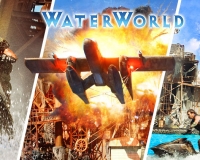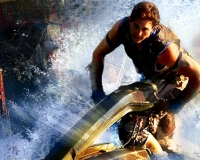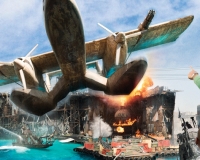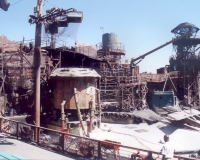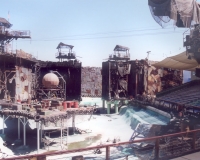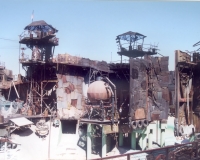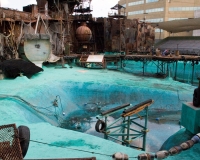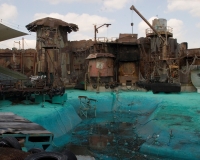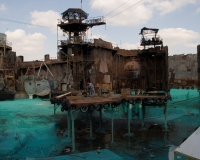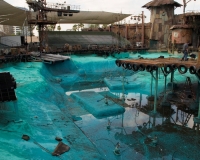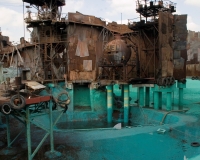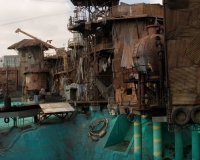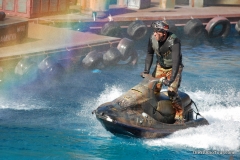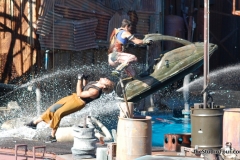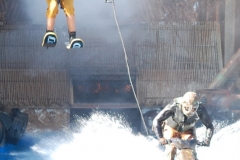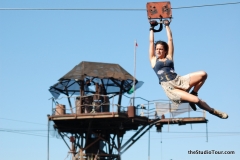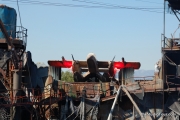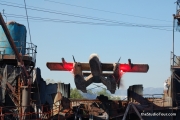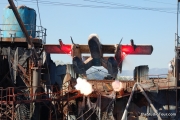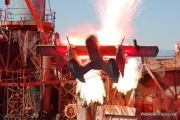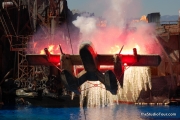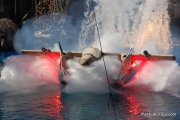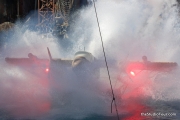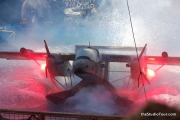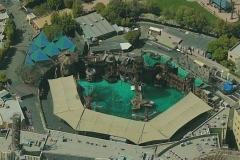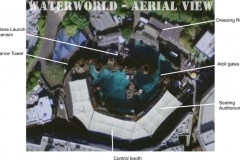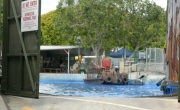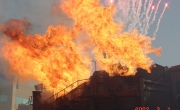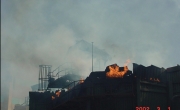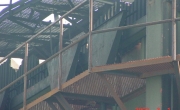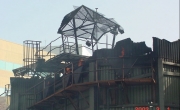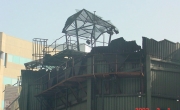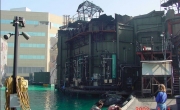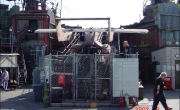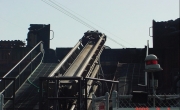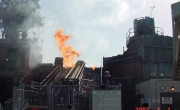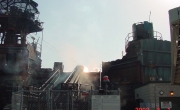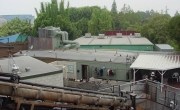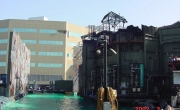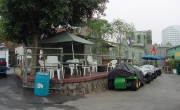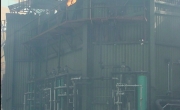Dates: 1995 – present
Consistently highly-rated among theme park live entertainment, the unlikely combination of Kevin Costner’s watery adventure movie, breathtaking stunts, pyrotechnics, flying props and the ultimate battle of good vs evil produces a full arena of thrilled audiences on a daily basis.
Official website: http://www.universalstudioshollywood.com/attractions/waterworld/
Location: Arena adjacent to Universal Amphitheatre.
Timeline:
1984 – 1986: A Team Live Action Stunt Show
1987 – 1995 – Miami Vice Action Spectacular
October 1994 – Preproduction meetings
January 1995 – Construction starts in the arena
February 1995 – Atoll construction starts
July 1995 – The pool is filled with 1.4 million gallons of recycled water for three intensive months of rehearsal.
Autumn 1995 – Show opens (planned opening, announced in May 1995 was October 23 1995)
24 Jan 2006 – 7 April 2006 – Show closed for refurbishment (repainting, remodelling of the set)
2007 – Show Control system refit (see below)
March 2014 – The show closes for annual refurbishment and it’s announced that the previous production company has been removed from the show. This includes some of the crew members, who are to be replaced with a new team.
April 2013 – The show re-opens after some minor re-working, and is now operated by Action Horizons, a company formed and run by professional stuntmen. They already were responsible for running the Universal Studios Singapore version of the WaterWorld show.
April 27 – May 19 2024: The Fall Guy Stuntacular Pre-Show runs before the main Waterworld show, to promote the release of the movie The Fall Guy starring Ryan Gosling and Emily Blunt. (see separate page)
The Making of WaterWorld
Work on the attraction started in October 1994, during production of Waterworld the movie. The team from Universal Studios Hollywood were searching for a replacement for the Miami Vice Stunt Show which was starting to show it’s age. Project Manager Norm Jahn was called to Hawaii to see the massive sets for the movie.
Facts and Figures
- Attraction setup cost: $15million
- Set cost: $1 million
- Running time: 16 minutes
- Show opened: Autumn 1995
- Size of show area: 40,000 sq.ft.
- Seating capacity of venue: 2500
- Main wall: 30 feet high
- Atoll gate towers: 35 feet high
- Main tower: 52 feet tall
- Entry tower: 42 feet tall
- Water: 1.4 million gallons of recycled water in the pool
- Number of cast: At the start of the show’s run there were 5 casts of 8 stuntpeople
Characters
- Deacon “Maniacal leader of a group of evil raiders called Smokers, determined to find Dry land first. He’s ensured that no explorer has ever returned until now”
- Helen
- The Mariner
- Gatesman / Boat Driver #1
- Stuntman
- Seth / Deacon’s Boat driver
- Pilot
- Kenny / Jet Ski driver
Only Deacon and Helen have live radio microphones – any other voices are recorded.
> View the Waterworld Cast photos over the years on the separate page.
Photo Gallery – Drained Tank
The WaterWorld tank has to be drained periodically for maintenance and repairs. Thanks to Skillz Entertainment for these photos from the year 2000!
Another refurbishment in 2006 involved draining the tank and applying a new blue paint job – thanks to David Crown for the photos.
Behind the Scenes
The Arena
- The 40,000 square foot facility contains a 23 feet-deep pool which was emptied out and widened before being painted blue for the production.
- Although much of the set is modelled on that used in the film, it was all constructed specifically for the Waterworld stunt show. The scenery built for the film was designed to be easily transportable, and to be safe when it’s blown apart on film. The show scenery, on the other hand, had to last for at least ten years and be repeatedly blown up, rebuilt and reset up to 15 times a day.
- The entry tower that the audience passes through to enter the arena is themed after the tower used by Gregor the balloonist in the film. It contains props from the film.
- The new materials were painted so they look old and rusted, and also to protect them from the aquatic environment.
- Steelwork was cut and welded in sizes that could be transported and then assembled and welded on site with the assistance of a number of cranes.
- The waves in the water (which help to break up the surface and disguise the true depth of the pool) are generated by a drum which is moved up and down in the water.
- As the pool is unheated, the performers wear wetsuits of differing thicknesses according to personal preference. There’s a hot tub behind the scenes for them to warm up before or after the show.
Sound / Music
The music played throughout the performance based on themes from the film score by James Newton Howard. Thanks to Josh James for the following information listing which parts of the movie soundtrack are used in the show, listed in order of their appearance in the live show:
- Track 17 – Deacons Speech – Looped before show starts (see video below)
- Track 1 – Main Title – Played under narrator
- Track 3 – The Atoll – Played as Helen enters Atoll
- Track 2 – Escaping The Smokers – Main Battle Theme
Walk-In Music:
Initial sound equipment:
50 x EAW and Panasonic/Ramsa speakers forming a 50,000 Watt sound system. Scenic housing for the speakers was built by Lexington Scenery as part of the set design.
In the current sound design, JBL and Tannoy speakers are used.
The lead actors wear radio microphones which relay their speech through the sound system. The sound stage manager is in the control booth at the rear of the auditorium. He or she plays back the pre-recorded music tracks and is also responsible for monitoring the radio microphones to ensure that everything is working and that the actors are OK. If there are problems with the show, the sound stage manager can talk to the actors through on-set speakers to tell them what\’s wrong and advise them on what to do. The sound stage manager also triggers the live “special effect” sounds (punches, explosions etc) which punctuate the show but cannot be accurately timed with a recorded soundtrack.
Pyrotechnics
- Bullet hits – During the strafing runs there are 50 bullet hits which jetskis and boats have to pass over at various times.
- Fire
- Weapons – The Gatling guns on the Deacon’s boat are electrically powered and have oxygen and acetylene tanks underneath them. The performer behind the gun presses two electrical buttons which spin the gun and trigger the gas flame jet effects.
There are 63 pyrotechnic effects for each 20 minute WaterWorld performance!
Safety is obviously of paramount importance – there are a number of safety devices built into the set which prevents dangerous effects (particularly pyrotechnics) from taking place if the conditions are not right. There’s an electronic eye sensor across the main walkway which tells the show control computer that a Mariner has passed a certain point, which means the pyrotechnic explosion can be safely triggered.
There are also wind sensors at high level around the arena which again prevent certain effects from happening if the wind speed is too high.
Every “launch” effect (the Mariner’s first entrance, the jetski and water-skiier through the wall etc) have technical operators with full view of the performers who press an “enable” button when all is set. When the show control computer gives the command to countdown and then launch, nothing will happen unless the enable button is being pressed, and other automatic safety checks come back with positive results. There are also emergency stop buttons which can be pressed if there are any problems.
As the aim is to continue the show wherever possible, there are alternatives for most of the technical effects which are put into action if the effect cannot be achieved for any reason. These ensure that the audience are usually unaware there is a problem and the show keeps running.
Show Control
The system was replaced in 2007 (after 12 years of operation). This video documents the upgrade project.
Scenic Effects
Atoll gates: 10′ wide, 30′ high, weighing approx. 3 tons.
Built by Advanced Entertainment Technology.
Stunts
There are more than 50 stunts during the show, needing a wide range of skills from jetski jumps, via high wire work to high falls into water.
Jetskis
The specially modified Jetskis used in the show are Kawasaki 550s, Kawasaki X2s and Kawasaki Supersports. They’ve been fitted with extra bilge pumps and have had the motors modified to cope with the heavy usage on WaterWorld. The numerous tyres around the tank edges are to protect the sets (and jetskis and actors) from damage if targets are missed.
Stunts
- Mariner’s first entrance is on a jetski from under water – he starts at the top of a metal slide backstage and is released down the ramp on cue, around 8 feet under water, under the set wall and up to the surface just as air cannons produce a “water explosion”.
- 40 feet long hydraulic catapult launch for jet ski and water ski stunts. The jetskier and water skiier are propelled through a wall, thrown 30 feet through the air before landing on the water’s surface. Two synchronised catapults propel the performers forward from 0 – 20 miles per hour in just over 1 second.
- Counterweight ride – stunt where the Mariner is pulled from under the water to the top of the main tower.
- Crane suspended over the Organo Pit – stuntman is hung from his ankles and dropped into pit.
- Slide-for-life stunts on high wire
- Fire Jump – the actor doing the Deacon’s fire jump is not the same actor who plays the Deacon for the rest of the show. They swap behind the tower. The fire jump actor wears a Nomex flame-resistant body suit, with a fireproof copy of the Deacon’s costume over it. On his head is a flame proof bald cap which covers the whole of the top, back and sides of his head. Only his face is exposed, which is covered with a flame-resistant gel.
- Seaplane At the climax of the second section of the performance, a 2,200lb seaplane is launched from a 30 foot hydraulic launcher before flying through a breakaway wall (with explosions), skidding across the water, and stopping 30 feet from the audience before exploding in a shower of sparks. As it hits the water it picks up another 300lb of weight of water. The seaplane is completely free-flying – there are no wires. There are wind sensors all around the arena which tell the show control computer to abort the launch if there’s a chance the plane could be blown off-course.
After the audience have left, a crane (which is a part of the set) is used to lift the plane back into position.
The seaplane catapult mechanism was originally tested at Falls Lake to experiment with the system before it was installed at the arena.
The seaplane concept is protected by a patent which can be viewed at Google Patents. The list of inventors is Nicholas H. Drobnis, Norman J. Kahn (producer), Randall G. Novak, Scott H. Smith, Thomas A. Garcia, Jr., David MacMurtry, Robert A. MacDonald and Christopher Brown.
Aerial Views
Backstage
The backstage area contains a continuation of the water tank, and areas for the cast and crew to relax, change into costume, and eat between shows.
Contractors
- Solberg & Lowe – (architect)
- IWA Engineers – (civil engineer)
- Ficcadenti & Waggoner (building / structural engineer)
- Kushner & Associates (mechanical engineer)
- Lucci and Associates (electrical wiring)
- Lexington Scenery & Props (set construction & detailing)
- Advanced Entertainment Technology (atoll gates & other action equipment)
- SpectraF/X – Seaplane
More Information
References: TCI, April 1996 – “Waterworld Live” by Robert Cashill
In Real Time: WaterWorld (2006) – http://www.trojanvision.com/media/ TrojanVision website

